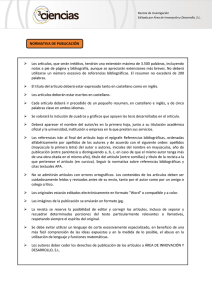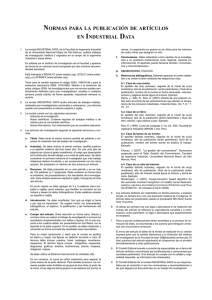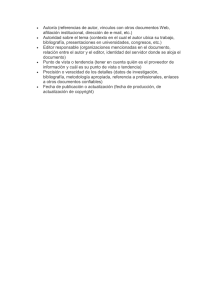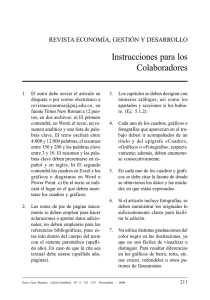enlace - Elsevier
Anuncio
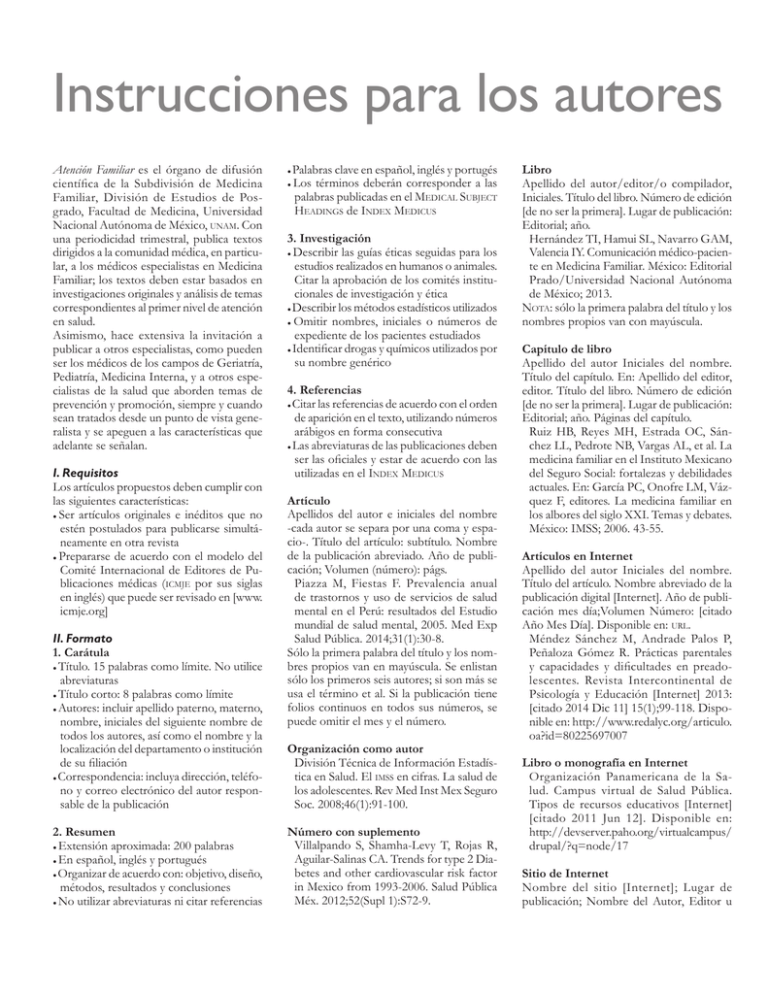
Instrucciones para los autores Atención Familiar es el órgano de difusión científica de la Subdivisión de Medicina Familiar, División de Estudios de Posgrado, Facultad de Medicina, Universidad Nacional Autónoma de México, unam. Con una periodicidad trimestral, publica textos dirigidos a la comunidad médica, en particular, a los médicos especialistas en Medicina Familiar; los textos deben estar basados en investigaciones originales y análisis de temas correspondientes al primer nivel de atención en salud. Asimismo, hace extensiva la invitación a publicar a otros especialistas, como pueden ser los médicos de los campos de Geriatría, Pediatría, Medicina Interna, y a otros especialistas de la salud que aborden temas de prevención y promoción, siempre y cuando sean tratados desde un punto de vista generalista y se apeguen a las características que adelante se señalan. I. Requisitos Los artículos propuestos deben cumplir con las siguientes características: ● Ser artículos originales e inéditos que no estén postulados para publicarse simultáneamente en otra revista ● Prepararse de acuerdo con el modelo del Comité Internacional de Editores de Publicaciones médicas (icmje por sus siglas en inglés) que puede ser revisado en [www. icmje.org] II. Formato 1. Carátula ● Título. 15 palabras como límite. No utilice abreviaturas ● Título corto: 8 palabras como límite ● Autores: incluir apellido paterno, materno, nombre, iniciales del siguiente nombre de todos los autores, así como el nombre y la localización del departamento o institución de su filiación ● Correspondencia: incluya dirección, teléfono y correo electrónico del autor responsable de la publicación 2. Resumen ● Extensión aproximada: 200 palabras ● En español, inglés y portugués ● Organizar de acuerdo con: objetivo, diseño, métodos, resultados y conclusiones ● No utilizar abreviaturas ni citar referencias ● ● Palabras clave en español, inglés y portugés Los términos deberán corresponder a las palabras publicadas en el Medical Subject Headings de Index Medicus 3. Investigación ● Describir las guías éticas seguidas para los estudios realizados en humanos o animales. Citar la aprobación de los comités institucionales de investigación y ética ● Describir los métodos estadísticos utilizados ● Omitir nombres, iniciales o números de expediente de los pacientes estudiados ● Identificar drogas y químicos utilizados por su nombre genérico 4. Referencias ● Citar las referencias de acuerdo con el orden de aparición en el texto, utilizando números arábigos en forma consecutiva ● Las abreviaturas de las publicaciones deben ser las oficiales y estar de acuerdo con las utilizadas en el Index Medicus Artículo Apellidos del autor e iniciales del nombre -cada autor se separa por una coma y espacio-. Título del artículo: subtítulo. Nombre de la publicación abreviado. Año de publicación; Volumen (número): págs. Piazza M, Fiestas F. Prevalencia anual de trastornos y uso de servicios de salud mental en el Perú: resultados del Estudio mundial de salud mental, 2005. Med Exp Salud Pública. 2014;31(1):30-8. Sólo la primera palabra del título y los nombres propios van en mayúscula. Se enlistan sólo los primeros seis autores; si son más se usa el término et al. Si la publicación tiene folios continuos en todos sus números, se puede omitir el mes y el número. Organización como autor División Técnica de Información Estadística en Salud. El imss en cifras. La salud de los adolescentes. Rev Med Inst Mex Seguro Soc. 2008;46(1):91-100. Número con suplemento Villalpando S, Shamha-Levy T, Rojas R, Aguilar-Salinas CA. Trends for type 2 Diabetes and other cardiovascular risk factor in Mexico from 1993-2006. Salud Pública Méx. 2012;52(Supl 1):S72-9. Libro Apellido del autor/editor/o compilador, Iniciales. Título del libro. Número de edición [de no ser la primera]. Lugar de publicación: Editorial; año. Hernández TI, Hamui SL, Navarro GAM, Valencia IY. Comunicación médico-paciente en Medicina Familiar. México: Editorial Prado/Universidad Nacional Autónoma de México; 2013. Nota: sólo la primera palabra del título y los nombres propios van con mayúscula. Capítulo de libro Apellido del autor Iniciales del nombre. Título del capítulo. En: Apellido del editor, editor. Título del libro. Número de edición [de no ser la primera]. Lugar de publicación: Editorial; año. Páginas del capítulo. Ruiz HB, Reyes MH, Estrada OC, Sánchez LL, Pedrote NB, Vargas AL, et al. La medicina familiar en el Instituto Mexicano del Seguro Social: fortalezas y debilidades actuales. En: García PC, Onofre LM, Vázquez F, editores. La medicina familiar en los albores del siglo XXI. Temas y debates. México: IMSS; 2006. 43-55. Artículos en Internet Apellido del autor Iniciales del nombre. Título del artículo. Nombre abreviado de la publicación digital [Internet]. Año de publicación mes día;Volumen Número: [citado Año Mes Día]. Disponible en: url. Méndez Sánchez M, Andrade Palos P, Peñaloza Gómez R. Prácticas parentales y capacidades y dificultades en preadolescentes. Revista Intercontinental de Psicología y Educación [Internet] 2013: [citado 2014 Dic 11] 15(1);99-118. Disponible en: http://www.redalyc.org/articulo. oa?id=80225697007 Libro o monografía en Internet Organización Panamericana de la Salud. Campus virtual de Salud Pública. Tipos de recursos educativos [Internet] [citado 2011 Jun 12]. Disponible en: http://devserver.paho.org/virtualcampus/ drupal/?q=node/17 Sitio de Internet Nombre del sitio [Internet]; Lugar de publicación; Nombre del Autor, Editor u Organización que lo publica. [Actualizado Año Mes Día; citado Año Mes Día]. Disponible en: url. Nota: para cualquier otro caso no referido aquí favor de consultar la Librería Nacional de Medicina de los Institutos Nacionales de Salud (EU) en el siguiente vínculo: [http:// www.nlm.nih.gov/bsd/uniform_requirements.html] 5. Cuadros ● Revisar que la información contenida en los cuadros no se repita con el texto o las figuras ● Numerados de acuerdo con su orden de aparición en el texto ● El título de cada cuadro debe por sí solo explicar su contenido y permitir correlacionarlo con el texto acotado 6. Figuras ● Están consideradas como tales las fotografías, dibujos, gráficas y esquemas ● Citar las referencias, cuadros y figuras consecutivamente y conforme aparezcan en el texto ● Adjuntar los valores de gráficas y esquemas en archivo Excel 7. Fotografías Deben ser de excelente calidad, en formato digital ( jpg o tif), con resolución mínima de 300 dpi y tamaño de 15 cm como mínimo; preferentemente a color. 8. Agradecimientos ● Incluirlos si el artículo lo requiere ● Extensión aproximada: 2 renglones III. Extensión de manuscritos ● Artículos originales hasta 3,000 palabras en total ● Artículo de revisión 1,500 palabras ● Caso clínico (estudio de salud familiar) 3,500 palabras ● Temas de interés 1,500 palabras ● Identifique el caso 500 palabras ● Cartas al editor 500 palabras IV. Procedimiento para la selección de artículos Los textos recibidos se someterán a dictamen por pares académicos bajo la modalidad de doble ciego, a fin de garantizar una selección imparcial de los artículos publicados. Una vez hecho el dictamen se informará al autor y se continuará el proceso de acuerdo con el resultado: ● El artículo fue aceptado y se publicará con modificaciones mínimas o de estilo El artículo es susceptible de ser publicado si se realizan los cambios que señalen los dictaminadores y/o el editor, con la finalidad de completar o aclarar el proceso metodológico de la investigación ● El artículo es rechazado, en cuyo caso se harán las explicaciones u observaciones pertinentes a su autor De existir controversias entre los dictaminadores respecto a la publicación, los miembros del Comité determinarán el resultado final. ● V. Cesión de derechos El responsable de la publicación deberá escribir para solicitar los siguientes formatos a: atencionfamiliar@fmposgrado.unam.mx ● Carta de transferencia de derechos a favor de Atención Familiar ● Formulario de no conflicto de intereses ● Adendum del comité de ética (copia de la aprobación por el comité de ética correspondiente); mismos que deberán ser debidamente llenados y firmados por todos los autores del artículo También deberá confirmar que tiene el permiso escrito de todas las personas a las que se ofrezca reconocimiento y sean mencionadas en el artículo. Instructions for Authors Atención Familiar is the organ of scientific diffusion of the Family Medicine Subdivision, Division of Graduate Studies, Faculty of Medicine, of the National Autonomous University of Mexico, unam. With a quarterly periodicity, the texts are addressed to the medical community, in particular to Family Physicians; all texts should be based on original research and analysis of issues relevant to the primary care level. Also, it does extend the invitation to publish to other specialists, such as doctors in the fields of Geriatrics, Pediatrics, Internal medicine, and other health specialists that may address issues of prevention and promotion, provided that they are treated from a general point of view and adhere to the characteristics which are further described. I. Requirements The proposed articles must comply with the following characteristics: ● Original and unpublished articles that are not postulated to be published simultaneously in another magazine ● Prepared according to the model of the International Committee of Medical Journal Editors (icmje) that can be revised at [www. icmje.org]. II. Format 1. Cover ● Title. Limit: 15 words. Do not use abbreviations ● Short title: Limit: 8 words ● Authors: include first and second names, initials, if the case, names of all authors, as well as the name and location of the department or institution of their filiation ● Correspondence: include address, telephone number and email address of the author responsible for the publication 2. Summary ● Length: 200 words approximately ● In Spanish, English and Portuguese Organize according to objective, design, methods, results and conclusions ● Do not use abbreviations or cite references ● Key words in Spanish, English and Portuguese ● The terms must correspond to the words published in the medical subject headings from index medicus ● 3. Research ● Describe the ethical followed guidelines of studies in humans or animals. Quote approval of the institutional research and ethics committees ● Describe the statistical methods used ● Omit names, initials, or file numbers of the studied patients ● Identify drugs or chemicals used by their generic name 4. References ● Quote references according to their order of appearance in the text, using Arabic numbers consecutively ● If using abbreviations, they should be the official ones and according to the index medicus Article Last name and initials of the author’s name -each author’s name should be separated by a comma and space-. Article title: subtitle. Name of the publication abbreviated. Year of publication; Volume (number): pp. Piazza M, Fiestas F. Prevalencia anual de trastornos y uso de servicios de salud mental en el Perú: resultados del Estudio mundial de salud mental, 2005. Med Exp Salud Pública. 2014;31(1):30-8. In Spanish, only the first word of the title and proper names are capitalized. Only six authors are listed: if there are more the et al term is used. If the publication has continuous numbering in all their numbers, you can omit the month and the number. del Seguro Social: fortalezas y debilidades actuales. En: García PC, Onofre LM, Vázquez F, editores. La medicina familiar en los albores del siglo XXI. Temas y debates. México: IMSS; 2006. 43-55. Articles on the Internet Author’s last name first name initial. Title of the article. Abbreviated name of the digital publication [Internet]. Year, month, day of publication; Volume number: [approximate number of windows]. Available at: url. Méndez Sánchez M, Andrade Palos P, Peñaloza Gómez R. Prácticas parentales y capacidades y dificultades en preadolescentes. Revista Intercontinental de Psicología y Educación [Internet] 2013: [citado 2014 Dic 11] 15(1);99-118. Disponible en: http://www. redalyc.org/articulo.oa?id=80225697007 Organization as author División Técnica de Información Estadística en Salud. El imss en cifras. La salud de los adolescentes. Rev Med Inst Mex Seguro Soc. 2008;46(1):91-100. Book or monograph on the Internet Organización Panamericana de la Salud. Campus virtual de Salud Pública. Tipos de recursos educativos [Internet] [citado 2011 Jun 12]. Disponible en: http://devserver.paho.org/virtualcampus/ drupal/?q=node/17 Supplement number Villalpando S, Shamha-Levy T, Rojas R, Aguilar-Salinas CA. Trends for type 2 Diabetes and other cardiovascular risk factor in Mexico from 1993-2006. Salud Pública Méx. 2012;52(Supl 1):S72-9. Web site Name of the Web site [Internet]; Place of publication; Author’s name, Publisher or Organization that publishes it. [Updated Date Year Month Day; quoted Year Month Day. Available at: url. Book Author’s last name/editor/ or compiler, Initials, Book title. Number of edition [if it is not the first]. Place of publication: Editorial or Publisher; year. Hernández TI, Hamui SL, Navarro GAM, Valencia IY. Comunicación médico-paciente en Medicina Familiar. México: Editorial Prado/Universidad Nacional Autónoma de México; 2013. note: in Spanish, only the first word of the title and proper nouns are capitalized. Note: for any other cases not mentioned here please consult the National Library of Medicine-National Institutes of Health (US) at the following link: [http://www.nlm.nih. gov/bsd/uniform_requirements.html] Chapter of a book Author’s last name, First name Initials. Title of the chapter. In: Last name of the editor, editor. Title of the book. Number of editions [if it is not the first edition]. Place of publication: Publisher; year. Pages of the chapter. Ruiz HB, Reyes MH, Estrada OC, Sánchez LL, Pedrote NB, Vargas AL, et al. La medicina familiar en el Instituto Mexicano 5. Charts ● Check that the included information in the charts will not be repeated in the texts or pictures ● Numbered according to their order of appearance in the text ● The title of each chart must, by itself, explain its contents and allow correlating it with the enclosed text 6. Figures ● These are photographs, drawings, graphs, and diagrams ● Quote references, tables and figures consecutively as they appear in the text ● Enclose graphs and diagram’s values in Excel file 7. Pictures They must be of excellent quality, in digital format (jpg or tif), with a minimum resolution of 300 dpi and minimum size of 15 cm; preferably color. 8. Acknowledgements ● Include them (if the article requires it) ● Approximate length: 2 lines III. Length of manuscripts ● Original articles up to 3,000 words ● Reviewed article 1,500 words ● Clinic report (family health study) 3,500 words ● Topics of interest 1,500 words ● Identify the case 500 words ● Letters to the editor 500 words IV. Procedure for the selection of articles The received texts will undergo opinion by academic peers in the form of double-blind, in order to ensure a fair selection of the published articles. Once they reach an opinion, the author will be informed and the process will continue according to the result: ● The article was accepted and it will be published with minimal modifications or style modifications ● The article is likely to be published if changes are made according to the reviewers and/or editor, in order to complete or clarify the methodological research process ● The article was rejected; in this case the author will receive the relevant explanations or observations If there is controversy between reviewers regarding the publication, members of the Committee will determine the final outcome. V. Assignment of copyright The owner of the investigation should write to atencionfamiliar@fmposgrado.unam.mx to request the following forms: ● Copyright transfer letter in favor of Atención Familiar ● No conflict of interest form ● Ethics committee addendum (copy of the approval by the ethics committee concerned); which must be completed and signed by all authors of the article Authors should also confirm that they have written permission from all persons who provide recognition and are mentioned in the article.
